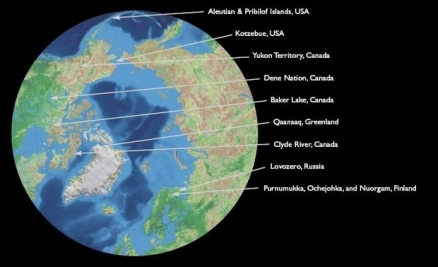Aleutian and Pribilof Islands region climate change case study
This is Section 3.4.2 of the Arctic Climate Impact Assessment; one of nine Arctic climate change case studies using indigenous knowledge. Case Study Authors: The Aleutian and Pribilof Islands Region,Alaska: Michael Zacharof, Greg McGlashan, Michael Brubaker,Victoria Gofman
The Aleut International Association (AIA) and the Aleutian and Pribilof Islands Association (APIA) prepared this summary of current observations, concerns, and plans related to climate change in their region. Michael Zacharof is President of AIA and lives on St. Paul Island in the Bering Sea. Greg McGlashan is the Tribal Environmental Programs Director on St. George Island. Michael Brubaker is the Community Services Director for APIA. Victoria Gofman is Executive Director of AIA.
There are several examples of how climate change is affecting people and communities in the Aleutian and Pribilof Islands region. The Nelson Lagoon Tribal Council has been concerned for several years about the effect of changing weather patterns on the narrow spit of sand they occupy between Nelson Lagoon (a prime nesting habitat for Steller’s eider (Polysticta stelleri)) and the Bering Sea. The changing climate is having dramatic effects on the security of the village and the local infrastructure.
Like many Alaskan coastal communities, Nelson Lagoon has been battling the effects of winter storms for years, most notably by building increasingly strong breakwalls along the shore. The increasing violence of the storms and changing winter sea-ice patterns have exacerbated the problem, reducing sections of a structure they hoped would provide decades of protection to kindling within just a few seasons. This is because their breakwall was designed to brace the shore ice, which would in turn provide the real buffer from winter storm wave action. As the winters have been warmer over the past six years, the buffer provided by the shore ice has been lost, allowing the full force of the waves to surge against the wall and the village.
In addition to the breakwall, other vital infrastructure has been disrupted by the changing weather patterns. In 2000, the pipeline that provides the village’s drinking water was threatened when storm waves eroded cover soil and caused a breach in the line. US Public Health Service engineers made an emergency trip to Nelson Lagoon to help repair the damage.
Based on these events, the Nelson Lagoon Tribal Council applied for funding from the US Environmental Protection Agency to establish a tribal environmental program with a focus on community planning and increasing understanding about the long-term impacts of climate change. This program is currently under development.
Other climate-related observations from the Aleutian Islands include the presence of non-indigenous warm-water fish species. One example is salmon sharks (Lamna ditropis), which have been observed as far north as False Pass, an important migratory passage for whales, salmon, and other marine life between the North Pacific and Bering Sea. It is likely that salmon sharks will soon be seen in the Bering Sea, competing for resources with marine mammals such as the Steller sea lion (Eumetopias jubatus).
On the Pribilof Islands in the Bering Sea, many changes have been seen. On St. George Island, the gravel of Staraya Artil Beach is being washed away, leading to shoreline erosion. As the gravel recedes and sea level rises, various artifacts and animal bones are appearing. No one on the island has seen anything like this before. On neighboring St. Paul Island, the 2002/2003 winter was warm with little snow. As a result, there were few eiders, which reduced subsistence hunting opportunities. On the other hand, northern fur seals (Callorhinus ursinus) and Steller sea lions remained on the island throughout the winter.
For such reasons, the Aleut are interested in finding better ways to monitor and study climate-related changes in the region, as well as to affect global policies. The Aleut International Association recognizes the need for comprehensive monitoring of the Bering Sea region from the Alaska Peninsula in the east to the Commander Islands in Russia in the west. Climate change should be an integral part of such monitoring. Although climate change observations in the region are numerous, almost no systematic records have been analyzed to document climate change, either in Alaska or Russia.
The Aleut, who live in the region all year round, have intimate knowledge of the land, sea, and climate. They are an invaluable resource and important partners in research. Currently, Aleut tribes in Alaska are developing their marine research capacity, which includes working with villages all along the Aleutian chain and engaging the region’s small-boat fishing fleet. This is a large untapped resource, which could provide an effective link between traditional and western knowledge, involve the region’s people in efforts to understand scientific research, and empower those most affected by climate change and its impacts. The current tribal structure and environmental program capacity provide excellent opportunities for research focused on climate change and other emerging issues. The Aleut International Association enables international research and monitoring in the Bering Sea by connecting peoples and governments on both sides of the Bering Sea and by helping the Aleut people address the most vital problems that they face today, one of which is climate change.
3.1. Introduction (Aleutian and Pribilof Islands region climate change case study)
3.2. Indigenous knowledge
3.3. Indigenous observations of climate change
3.4. Case studies (Aleutian and Pribilof Islands region climate change case study)
3.4.1. Northwest Alaska: the Qikiktagrugmiut3.5. Indigenous perspectives and resilience
3.4.2. The Aleutian and Pribilof Islands region, Alaska
3.4.3. Arctic Athabaskan Council: Yukon First Nations
3.4.4. Denendeh: the Dene Nation’s Denendeh Environmental Working Group
3.4.5. Nunavut
3.4.6. Qaanaaq, Greenland
3.4.7. Sapmi: the communities of Purnumukka, Ochejohka, and Nuorgam
3.4.8. Climate change and the Saami
3.4.9. Kola: the Saami community of Lovozero
3.6. Further research needs
3.7. Conclusions (Aleutian and Pribilof Islands region climate change case study)
